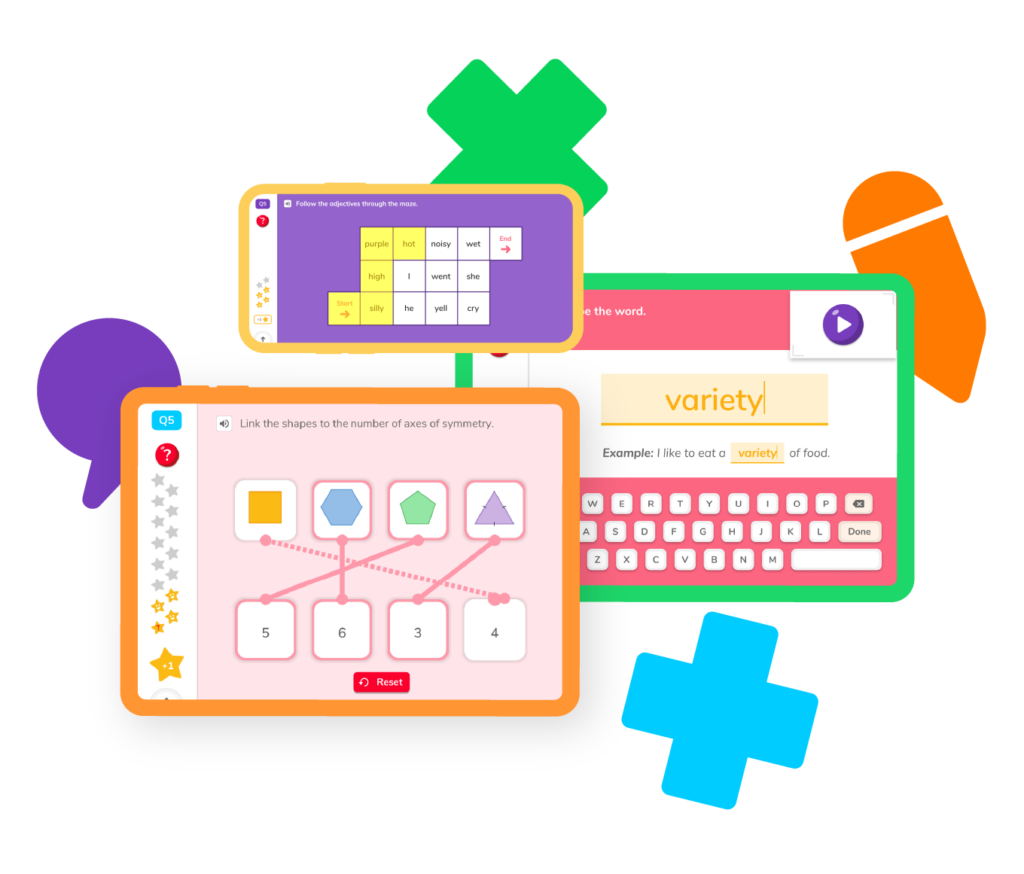Home → Maths → Year groups
From getting to grips with numbers and basic operations in Year 1 to mastering the skills of long division and long multiplication in Year 6 – there’s a lot to cover in your child’s primary school maths journey! Thankfully, DoodleMaths has you covered with a whole host of amazing resources. Select your child’s year group below and start learning!

If you find yourself a bit stuck on how to help your child with a tricky maths topic or simply want to know what they’ll cover in a year, then these resources are for you!
Well, a lot! In the six years your child spends in primary school, they’ll learn a wide variety of mathematical skills and concepts.
In Year 1, students learn how to add, subtract, multiply and divide numbers up to 20, identify basic fractions, learn coin values and be introduced to simple concepts within measure and shape.
Students in Year 2 work with numbers up to 100 to build on their skills from last year. They’ll learn simple fractions, how to measure using units and tell time to the nearest five minutes.
In Year 3, children will work with numbers up to 1,000, learn their 3, 4, and 8 times tables, measure perimeter, order fractions and find equivalent fractions, and calcuate periods of elapsed time.
Year 4 students learn all multiplication tables, how to calculate the perimeter of shapes, and are introduced to angles. They’ll also explore different types of graphs and charts.
Learners in Year 5 will be introduced to long multiplication and a range of more complicated fractions concepts and will be able to draw and measure different categories of angles accurately.
Year 6
In Year 6 learners are introduced to long division and new topics of algebra and ratio and proportion. This year they’ll focus on using their skills independently to solve a range of different maths problems.
Following the national curriculum primary maths learning is split into two key stages. Students in Year 1 and Year 2 follow the Key Stage 1 programme, while Years 3 to 6 fall under Key Stage 2. But what exactly is the difference?
Key Stage 1 is where students will build their foundational skills and experience with basic maths concepts. They’ll cover six main mathematical areas including; place value, addition and subtraction, multiplication and division, fractions, measurement, and geometry.
In each of these areas, students will be introduced to and get plenty of practice with various aspects of maths, eventually using numbers up to 100 to complete different calculations. They’ll learn the basics of telling the time, measurement and shapes too, including the names of various 2D and 3D shapes.
As of 2024, there are no statutory maths assessments for Key Stage 1 students. Previously, students were required to sit an end of Key Stage 1 SAT assessment, but this has now been made optional.
As they enter Year 3 maths learners will begin their work on Key Stage 2 (KS2), which will take them through the rest of their primary school years.
By the end of Key Stage 2 maths, learners will have covered nine different mathematical topics – these include statistics, algebra, and ratio and proportion in addition to the six topics covered in Key Stage 1.
Key Stage 2 is split into two halves; lower KS2 (Year 3 and Year 4) and upper KS2 (Year 5 and Year 6).
In lower KS2, students are focusing on building additional skills in the different areas of maths. This includes using the four operations (addition, subtraction, multiplication, and division) with larger numbers, developing their awareness of different types of fractions, and introducing angles.
As they move into upper KS2, students will learn a few new concepts such as long multiplication, long division, and working across fractions, decimals and percentages.
In primary schools maths programmes aim to prepare students for their next stage of learning, which in this case, is secondary school. So, as they enter Year 6 maths, the main focus is encouraging learners to apply their skills independently and to solve a range of different problems.
There are lots of ways you can help your child to succeed in their national curriculum primary maths journey. The main way is to ensure they get lots of practice at perfecting their primary maths skills!
Making maths fun for them is a fantastic place to start. There are a whole range of ways you can do this like board games, video games, or even incorporating a little maths in your daily routine!
If you have a learner who loves playing maths games, then the DoodleLearning maths app could be the answer! The app has thousands of interactive maths games that will help your child develop their skills across the curriculum.
The app is fully aligned with the national curriculum and adults can track their little ones’ progress through the dashboard as they complete a personalised programme of maths games and activities!
Select a year group

Parents, sign up for a DoodleMaths subscription and see your child become a maths wizard!

Book a chat with our team
If you’d like to use Doodle’s browser version, please visit this page on a desktop.
To log in to Doodle on this device, you can do so through our apps. You can find out how to download them here: